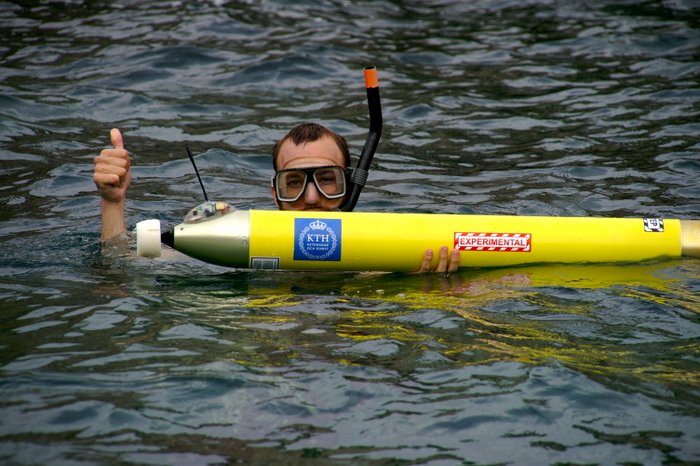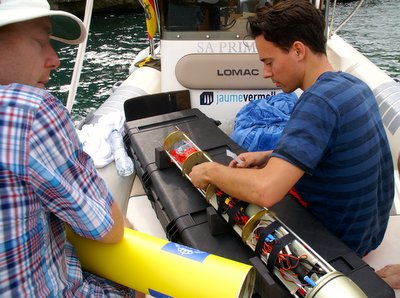Drones could help tap oceans' potential

KTH scientists are already drawing renewable energy from the sea, yet beneath the surface of the world’s oceans lies a universe of secrets that could benefit humanity even further. The trick is just getting down there – and coming back up.
Exploration of the deep relies often on remote controlled submersible vehicles. But development of autonomous underwater vehicles (AUV) holds even greater promise for conducting far-ranging missions at the bottom of the ocean, where being tethered by a cable is not an option, says Professor Jakob Kuttenkeuler, who leads research at KTH’s Centre of Naval Architecture.
Displaying his experimental AUV, nicknamed “Carl”, on a recent internet broadcast of Crosstalks TV , Kuttenkeuler said his research is focused on making these drones, which resemble friendly torpedoes, more robust, more reliable and more suited to the needs of end users.

“Being under water is not a game”, Kuttenkeuler says. “The environment is tougher and rougher than outer space,” he says.
Despite its proximity, the ocean remains as much a mystery to humankind as the surface of a distant planet. So it’s a compelling frontier for scientists. Areas like the Marianas Trench, the deepest region of the oceans, represent a vast untapped store of knowledge about our world. Indeed, more people have set foot on the moon than have descended into the 11,000-metre depths of the Trench.
One of them was film director James Cameron, who piloted a record-breaking 2012 descent in a lightweight submersible designed by Ron Allum, a broadcast technician turned amateur mechanical engineer. Allum joined Kuttenkeuler on the Crosstalks broadcast to talk about the need for deep sea exploration.
“There is a territory the size of North America that’s below 6,000 feet (deep), and explorers let it lay dormant for quite some time,” Allum says. “It’s totally unexplored, and you don’t know what’s down there until you go and have a look”.
But it’s not only the deepest depths that require exploration and data collection. Beneath the ice shelves of Antarctica are areas too difficult to reach in piloted vessels, but where measurements nevertheless are needed in order to analyse the impact of global warming on polar ice.


“Climate change models need to be validated by data, and we need more data from the Arctic”, says Nina Kirchner, Senior Lecturer in Numerical Ice Sheet Modeling at Stockholm University. “We need measurements from the grounding line (of the ice shelf)”.
Used often in exploring underwater oil fields, AUVs recently made news in the search for the black box from the missing Malaysian Airlines Flight 370. Better batteries and more autonomous functionality are two keys to bringing systems like the KTH AUV up to the task of more diverse missions, as well as journeys under the Arctic ice shelf, which can total hundreds of kilometres in distance.
“Losing equipment in the sea is common,” Kuttenkeuler says. “As soon as we dive a few centimetres, you lose GPS, so not knowing where you are under a shelf of ice is a pain in the neck … it’s a nightmare.”
Small issues become big problems in the sea. Kuttenkeuler explains how the KTH AUV once unexpectedly reversed course and wound up stuck in the sand. “We need to collaborate more with other robotics researchers and with the end users in order to prepare for these situations,” he says. “We want it to perform missions without our interaction; once the AUV dives, basically we lose contact with it.”
But besides long-range missions, the AUV could play a significant role in the expanding business of sea farming, says Fredrik Gröndahl, an Associate Professor of Industrial Ecology at KTH.
“A sea farm requires surveillance,” says Gröndahl , who leads a project called Seafarms, which is focused on converting algae into green food, medicine, plastic and energy. “After a storm, for example, we have to control it. Material could drop to bottom and deplete the oxygen. But a robot could measure oxygen.”
Sea farms also become artificial reefs that attract fish, and this could also be surveyed with the use of AUVs, Gröndahl says, adding that other uses could be to monitor wave energy parks and wind parks.
“There will be huge possibilities for vehicles like ‘Carl’ to run around there.”
David Callahan
Department of Industrial Ecology at KTH
Jakob Kuttenkeuler's profile page at KTH